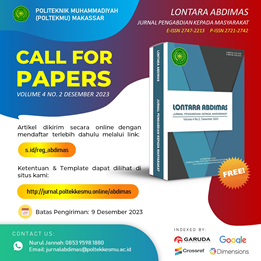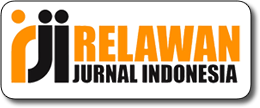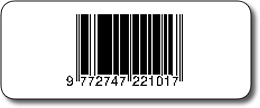Pemanfaatan Limbah Minyak Jelantah Menjadi Sabun Padat
Abstract
Used cooking oil contains compounds that are carcinogenic which pose a risk to human health. Waste cooking oil is also at risk for areas where used cooking oil is disposed, for example into sewers or into the ground. This can contaminate soil and water, thereby endangering humans or the surrounding environment. Therefore, serious action is needed on the use of used cooking oil waste so that it can be utilized optimally as a staple in the soap processing process. Through community service activities which are one of the implementations of the Tridharma of Politeknik Kesehatan Muhammadiyah Makassar Study Program of Medical Laboratory Technology, then education is carried out in the form of counseling to the taklim assembly team at the Al-Hidayah Perumnas Antang Makassar Mosque regarding the use of used cooking oil into solid laundry soap. From this community service activity, it can be concluded that the knowledge of the taklim team at the Al-Hidayah Mosque in Manggala Village, Manggala District, Makassar City regarding the dangers of used cooking oil waste for health and how to process used cooking oil into solid soap.
References
Badan Standarisasi Nasional., (1994). Standar Mutu Sabun Mandi. SNI 06-3532-1994. Dewan Standardisasi Nasional. Jakarta.
Ophardt, C. E. Soap. http://elmhurst.edu/- chm/vchembook/554soap.html.
Ramdja, A. F., Febrina, L., & Krisdianto, D. (2010). Pemurnian minyak jelantah menggunakan ampas tebu sebagai adsorben. Jurnal Teknik Kimia, 17(1).
Aisyah,S., Budiman, H., BR. G, D. F., Aliza, D., Salim, M. N., Balqis, U., & Armansyah, T. (2015). Efek Pemberian Minyak Jelantah Terhadap Gambaran Histopatologi Hati Tikus Putih (Rattus norvegicus) The effect of Administrating Waste Cooking Oil to Histopathology of Rat ( Rattus norvegicus ) liver. Jurnal Medika Veterinaria, 9(1), 1–4. https://doi.org/10.21157/j.med.vet..v9i1.2989
Kosasih, D. (2018). Minyak Jelantah Berpotensi Cemari Air dan Tanah. Retrieved from Greeners.Co website: https://www.greeners.co/berita/minyak-jelantah-berpotensi-cemari-air-dan-tanah/
Kusumaningtyas, R. D., & Qudus, N. (2019). Penerapan Teknologi Pengolahan Limbah Minyak Goreng Bekas Menjadi Sabun Cuci Piring Untuk Pengendalian Pencemaran Dan Pemberdayaan Masyarakat. Jurnal Abdimas, 22(2), 201–208.
Sari, P. (2019). PEMBUATAN SABUN MANDI PADAT DARI MINYAK JELANTAH DAN BIJI KAKAO (Theobroma cacao L.). Cokroaminoto Journal of Chemical Science, 1(1), 10-
Syafiq, A. 2007.Gizi dan KesehatanMasyarakat Edisi Revisi. Jakarta: Raja Grafindo Persada.13.
Almatsier, S. 2009. Prinsip Dasar Ilmu Gizi.Jakarta: PT. Gramedia Pustaka Utama
Winarno, F.G.1995.Kimia Pangan dan Gizi. Jakarta. PT Gramedia Pustaka Jaya Utama











